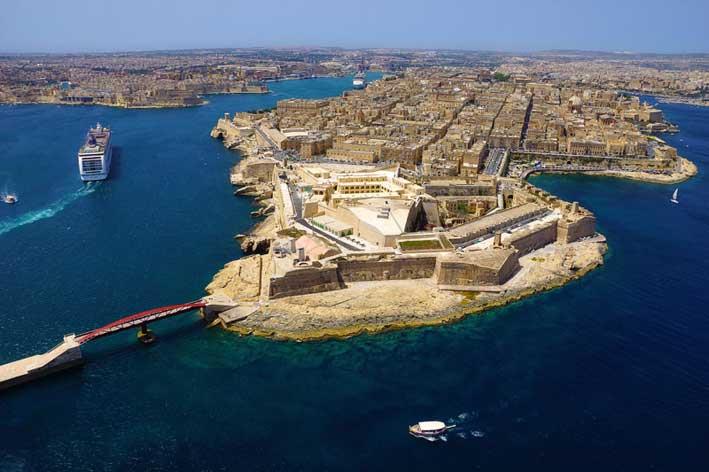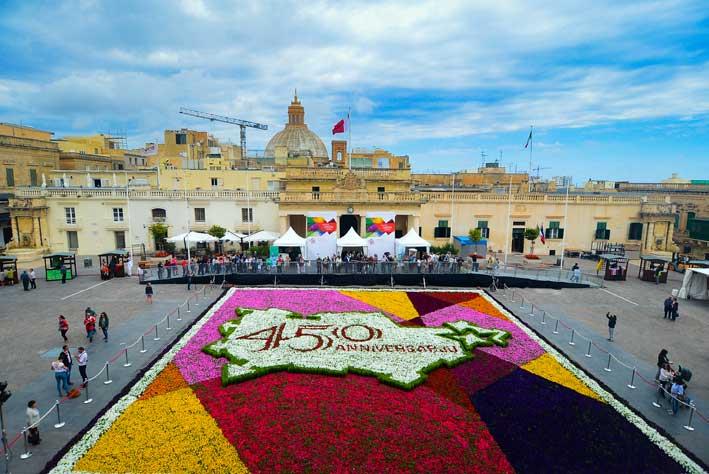The opening of V18 has been called a ‘festa’, a typical Maltese celebration. Keeping the European context in mind, how do things like the European diversity angle fit in?
The word festa is universal. We thought it was very important to have a European and international dimension in whatever we do. There, in one word, we are putting together what 2018 means for us: a festa. Festa means a large amount of colours, happiness, faces and diversity. A festa is unifying. Hispanics, English, Italians all recognise the word. To me it was a brilliant idea.
What is the artistic vision that makes V18 unique?
We wanted to have a strong cultural programme throughout the five years we had in front of us. That meant an economical, social and cultural regeneration whilst respecting the cultural programme, which would take place throughout the first four years but the core of which is in 2018. However, 2018 is not the destination, but rather, the beginning. Our programme is one which has a legacy and is sustainable. All that we are going to see this year we are determined to continue seeing in the coming years. For example, in the first half of this year we are going to have the first cultural agency of Valletta that will see the continuation of the Valletta 2018 Foundation.
What distinguishes Valletta as a city compared to others is that we are the only capital city in the world that is a UNESCO World Heritage Site. So we also want V18 to respect the architectural aspect and life of the capital. For this reason, the programme has a lot to do with community as well. I don’t really like to distinguish between countries, because each has their own nice points and differences, and that is the beauty of diverse cultures.

Can you tell me more about Valletta’s first cultural agency?
The cultural agency will be important for the continuity for the staff of V18, so when the end of V18 is near, things don’t come to a halt. We also know that this agency is going to merge with Festivals Malta and, together, we will organise cultural activities in Valletta, focusing especially on big festivals: New Year’s Eve celebrations, the Valletta Pageant of the Seas, Malta Fashion Week and other festivals that did not exist before Valletta 2018. God forbid that these end because we are no longer here.
What about festivals such as the Jazz Festival and the Baroque Festival? These existed before V18.
Yes, they existed before, but Valletta2018 invested in them. We have invested a lot through financial and human resources in many festivals, including the Jazz Festival, Ghanafest and the Mediterranean Literature Festival. We wanted to push them up a notch, and I think we have managed to do so. These will all continue with the support of the agency and the staff of Valletta 2018, in collaboration with Arts Council Malta and Festivals Malta.

You have often said that V18 will leave a lasting legacy. Can you elaborate?
The legacy of V18 is crucial; for me, it is the biggest success of 2018 and that is why we say 2018 is just the beginning. Why is it a legacy? Throughout 2018 we will start a series of big infrastructural projects that will play a huge part in the creative economy. These will attract more interest, more employment and more opportunities for artists.
One example is the National Museum and Community of Fine Arts (MUZA), which will be the envy of many Europeans and very different from the museum in South Street. It will be an interactive museum that will abolish the idea of people not going to a museum because they think they will not understand the artwork.
It will also be a place for workshops and gastronomy. The food at the café and restaurant of MUZA will represent what you have just seen, it will be a culinary experience linked with the arts. This is just a detail, but I am explaining what legacy we will leave behind us with infrastructural projects.
The Valletta Design Cluster will be open at the end of 2018. This is basically a project within the community from which the community will benefit. The old biccerija will be restored, we will have big spaces for artists-in-residence and we will give start-ups of a year for young artists who would not otherwise have the financial means after graduation to go into the working world. For me, this is a big legacy.
The running of the Valletta Design Cluster will be autonomous. Apart from that, there is also the work on the Valletta Market, which today people are seeing as a work of art, a marvel. Together with the Arts Council Malta, we have just signed a Memorandum of Understanding with the owners of the Market, with which we will have a board of artists running a cultural programme specifically for the Market, and that is our vision as to how – from a private-public partnership – we will have not only an economic and socially regeneration but also a cultural legacy

How much money has been spent on V18 in the last seven years and how much is expected to be generated through it during Valletta 2018?
I refuse to call it an ‘expenditure’ but would rather call it an ‘investment’. Between 2013 and the end of 2018, the government will have given the Foundation €60 million for administration, day-to-day running and creating all this programme. This does not include infrastructural projects such as the Triton Fountain project, the restoration of Castille Square and other façades, MUZA and so on.
The return on investment is huge; we still don’t have the statistics because I am waiting for them from other government authorities. It will be definitely more than €60 million: the interest in Valletta is very particular. Our estimate from the side of Malta Tourism Authority is an increase of between seven and 10 per cent in tourism in the year, because of V18. The Malta Tourism Authority has invested a lot in advertising Valletta over the last three years.
One problem for artists in Malta is that they struggle to find working spaces in which to rehearse and work. Is there anything being done about this?
I think we have done a lot, and we will continue doing more. The Valletta Design Cluster will be big enough to offer space and halls to respond to this need. There are other spaces too, such as Splendid in Strait Street, which we administrate together with other people, and where we have a lot of exhibitions for young artists. We also have our Artistic Director Giuseppe Schembri Bonaci, who has a programme year after year for Strait Street. We need to keep looking for spaces for artists, both established and just starting out, in order to continue helping them so they can explore their respective artistic sectors. Having said that, we have also invested in an artistic residence in Gharb. This is what Valletta 2018 means as well: a celebration of culture that does not only begin and end in Valletta. Meanwhile, we also support galleries and exhibition spaces in Valletta and, consequently, artists who are just starting out in their work.

Events during V18 will not be limited to Valletta, but will extend to other Maltese towns. Can you give us some examples of these?
Yes. We have performances in many theatres around Malta and Gozo, for example, both in bigger theatres as well as those less well-known in smaller towns. I think the communities are appreciating this. Not everything we do can be as popular and well-known as, for example, the New Year’s Eve celebrations we had in Valletta. But we believe in our slogan ‘Culture accessible to everyone’ – which means we are taking culture to people, and I think we have managed so far and are determined to continue. Another example is that, this year, Carnival festivities are going to extend to Cottonera and a spontaneous Carnival in Hal-Għaxaq.
A number of artists have had an issue with Artistic Director Mario Philip Azzopardi and, as a result, have disassociated themselves from V18. Can you confirm that everything is running smoothly now in this respect?
I can confirm that, with our structural and cultural programme, we have done a lot of work and have turned Valletta around – and I say this with all humbleness. The Foundation has managed to turn it around. The Valletta of today is not the dying capital city we had seven, eight, 10 years ago, but is vibrant and our only problem is how many people will be coming.
Mario Philip Azzopardi, like all artists, can be controversial: to be controversial in the artistic sector is normal! Everyone is now back ‘all hands on deck’ and I trust we will have an exceptional year.